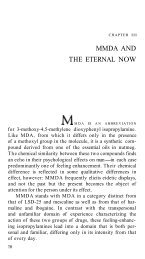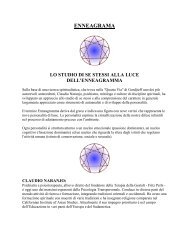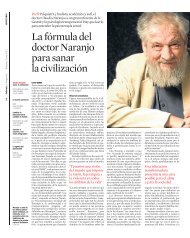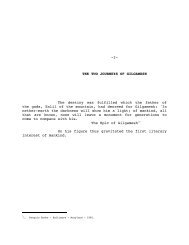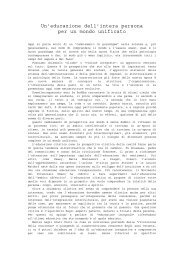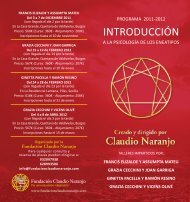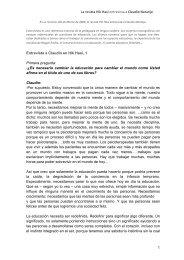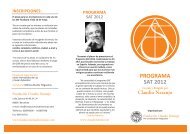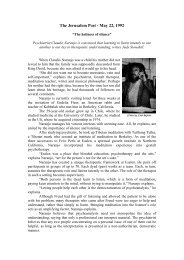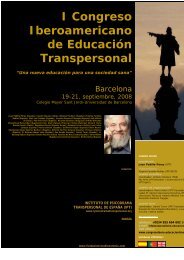Present – Centeredness in Gestalt Therapy Claudio Naranjo
Present – Centeredness in Gestalt Therapy Claudio Naranjo
Present – Centeredness in Gestalt Therapy Claudio Naranjo
Create successful ePaper yourself
Turn your PDF publications into a flip-book with our unique Google optimized e-Paper software.
never put anyth<strong>in</strong>g <strong>in</strong>to words; yet, with<strong>in</strong> limits, clarity of perception goes together with the ability<br />
to express, an artist be<strong>in</strong>g a master <strong>in</strong> awareness rather than a skilled patternmaker. And <strong>in</strong> art, as <strong>in</strong><br />
psychotherapy, the task of hav<strong>in</strong>g to communicate someth<strong>in</strong>g <strong>in</strong>volves hav<strong>in</strong>g to really look at it<br />
rather than dream<strong>in</strong>g about look<strong>in</strong>g.<br />
2. The presence of a witness usually entails an enhancement both of attention and of the<br />
mean<strong>in</strong>gfulness of that which is observed. I th<strong>in</strong>k too that the more aware an observer is, the more<br />
our own attention is sharpened by his mere presence, as if consciousness were contagious or one<br />
person could not as easily avoid see<strong>in</strong>g what is exposed to the gaze of another.<br />
3. The contents of consciousness <strong>in</strong> an <strong>in</strong>terpersonal sett<strong>in</strong>g will naturally tend to be that of the<br />
<strong>in</strong>terpersonal relationship, whereas the solitary meditator focused on the here and now will<br />
systematically fail to f<strong>in</strong>d such contents <strong>in</strong> his field of awareness. S<strong>in</strong>ce it is ma<strong>in</strong>ly the patterns of<br />
relat<strong>in</strong>g and the self-image <strong>in</strong> the process of relat<strong>in</strong>g that are disturbed <strong>in</strong> psychopathological<br />
conditions, this factor looms large <strong>in</strong> mak<strong>in</strong>g the here-and-now exercise a therapy when <strong>in</strong> the I-thou<br />
sett<strong>in</strong>g.<br />
4. The <strong>in</strong>terpersonal situation makes present-centeredness more difficult, for it elicits projection,<br />
avoidance, and self-delusion <strong>in</strong> general. For <strong>in</strong>stance, what for the solitary meditator may be a series<br />
of observations of physical states may, <strong>in</strong> the context of communication, become embedded <strong>in</strong> a<br />
feel<strong>in</strong>g of anxiety about the therapist's eventual boredom, or <strong>in</strong> an assumption that such<br />
observations are trivial, or that they show the patient's essential barrenness. The elicitation of such<br />
feel<strong>in</strong>gs and fantasies is important.<br />
a. If present-centeredness is a desirable way of liv<strong>in</strong>g which is usually marred by the<br />
vicissitudes of <strong>in</strong>terpersonal relationships, the challenge of contact entails the ideal tra<strong>in</strong><strong>in</strong>g<br />
situation. I would like to <strong>in</strong>vite the thought that the practice of liv<strong>in</strong>g <strong>in</strong> the moment is truly an<br />
exercise and not merely an occasion for self-<strong>in</strong>sight. Just as <strong>in</strong> behavior therapy, this is a<br />
process of desensitization <strong>in</strong> the course of which a person becomes free of the central<br />
condition<strong>in</strong>g of avoid<strong>in</strong>g experience, and he learns that there is noth<strong>in</strong>g to fear.<br />
b. Related to the above is the fact that it is precisely the awareness of the difficulties <strong>in</strong><br />
presentcenteredness that can provide the first step toward overcom<strong>in</strong>g them. Experienc<strong>in</strong>g<br />
the compulsive quality of brood<strong>in</strong>g or plann<strong>in</strong>g may be <strong>in</strong>separable from an appreciation of the<br />
alternative to them, and of a true understand<strong>in</strong>g of the dist<strong>in</strong>ction between these states of<br />
m<strong>in</strong>d and present-centeredness.<br />
5. The therapeutic context allows for a monitor<strong>in</strong>g of the process of self-observation, whereby the<br />
therapist br<strong>in</strong>gs the patient back to the present when he has been distracted from it (that is, from<br />
himself). There are two ma<strong>in</strong> ways of do<strong>in</strong>g this. The simplest (aside from merely rem<strong>in</strong>d<strong>in</strong>g him of<br />
the task) is to call his attention to what he is do<strong>in</strong>g unawares, by direct<strong>in</strong>g his attention to aspects<br />
of his behavior that seem to be automatic response patterns or to clash with his <strong>in</strong>tentional actions.<br />
Simply be<strong>in</strong>g mirror to him may serve to br<strong>in</strong>g <strong>in</strong>to focus his relationship to himself and his actions <strong>in</strong><br />
general:<br />
P.: I don't know what to say now....



